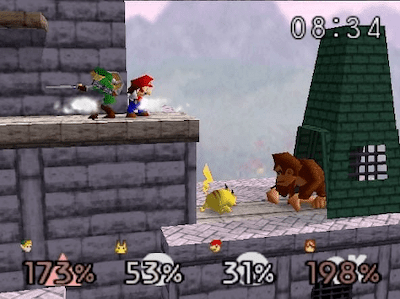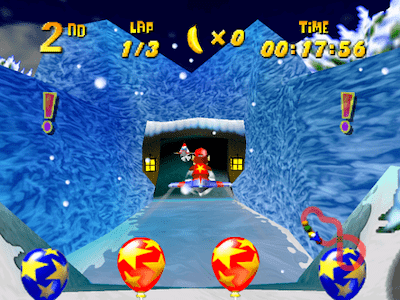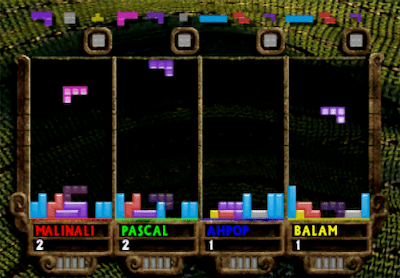Best Multiplayer N64 Games 101: The Essential Guide
It wasn’t easy for the N64 to earn its prestigious position in video gaming history. Despite a shocking lack of third-party support, the system made a name for itself with some of the best first-party titles ever made.
Most often, the system is remembered for one-player cult classics like Super Mario 64, Star Fox 64, Donkey Kong and The Legend of Zelda: Ocarina of Time. But it also offers tons of excellent multiplayer titles that get far less credit than they deserve.
Today, we’re going to remedy this injustice. The guide below lists the best N64 coop games you’ll ever play, period. If you’ve played all your other multiplayer games to death, try these additively competitive treats.
1. Super Smash Bros
Yes, we know you’ve played several other games in this series. And that means that you know  how unique each version is.
how unique each version is.
Specifically, most versions have exclusive playable characters, stages, and fighting moves. And, many of the sequels tweak the physics of their predecessors.
So, at first glance, this Super Smash Bros game seems rather limited. The original 12 characters are featured in every sequel, with many additional moves they didn’t have in the first game.
However, what this really means is that the original N64 release is the same game we all know and love, but in its purest form. The stages and gameplay are simple, straightforward, and well-balanced. 5 of the 8 stages are unique to this version and don’t return until Super Smash Bros Ultimate.
Most notably, the physics in this game are unlike any of the sequels. Characters seem more weightless when they fall and their actions are slower. This gives you more time to plan your attacks.
2. Perfect Dark
You may have expected us to include the FPS classic GoldenEye 007 on this list. The reason we didn’t is Perfect Dark.
It’s basically the same game—it’s even made by the same people—except that it’s better in every way. To be specific, in Perfect Dark:
- The characters are no longer flat-faced, block-headed freaks
- There are 3 multiplayer games instead of 1
- You can play the story mode as a 2-player co-op
- You can add NPC opponents in vs game modes
- You can customize weapon sets, your avatar, the music, and other settings
- There is no connection to a cheesy Bond movie from the 1990s
Seriously, Rare took everything that was brilliant about their original masterpiece, Goldeneye, and spent 3 years improving it. And the result was Perfect Dark: a polished upgrade to its predecessor with 25 times more depth.
------------------------------------------------------------------------------------------------------------------------------------------
Related Article: Super Nintendo vs Nintendo 64: Who has the Best RPG Games
------------------------------------------------------------------------------------------------------------------------------------------
3. Mario Party 2 & Mario Party 3
Yes, you’ve played several of these games, too. And, as with the previous game Perfect Dark, the creators of these games have had many years to perfect what makes them great.
So, how good could the second-oldest game in the series be? According to the reputable game reviewers at Den of Geek, it’s the best there is.
The game features tons of the best mini-games in the series, several game boards, and the super-challenging, 1-player minigame coaster. This title combines board game and video game fun better than any other game, with one possible exception.
There’s still a neverending debate over Mario Party 2 vs Mario Party 3. Many argue that 3 trumps 2 because it features way more game boards and many co op games.
So which is truly the best? Apparently, you’ll have to decide for yourself.
4. Diddy Kong Racing
Once again, we include an obscure title that trumps its extremely well-known competitor. Sadly,  Diddy Kong Racing never attained the prestige it deserved because gamers assumed it was “just another Mario Kart rip-off.” Plus, the titular character is a sidekick from a spinoff of another old Nintendo title.
Diddy Kong Racing never attained the prestige it deserved because gamers assumed it was “just another Mario Kart rip-off.” Plus, the titular character is a sidekick from a spinoff of another old Nintendo title.
It literally looks like the most derivative racing game possible. Shockingly, though, it’s actually deeper and far more enjoyable than Mario Kart 64.
Obviously, DKR is indeed a kart racing game, at first. But then, as you progress through the story mode, you unlock two additional types of racing vehicles: hovercrafts and planes.
This means you can enjoy all 20 racetracks in 3 different ways. That’s like 60 different racing experiences. Comparably, Mario Kart 64 has 16 tracks and 1 vehicle type. The game features a multiplayer mode for up to four players.
Plus, as mentioned, there’s a surprisingly decent story mode. Altogether, there are so many ways to love this game.
------------------------------------------------------------------------------------------------------------------------------------------
Related Article: How to tell if N64 game is Authentic or a Bootleg Video Game
------------------------------------------------------------------------------------------------------------------------------------------
5. Gauntlet Legends
For a game as perfectly simplex as Gauntlet Legends, there’s really not much to say. It brings the classic arcade hit home as a console game for play on your Nintendo 64.
In other words, you and 3 buddies sit on a couch all day to hack-and-slash the bejeezus out of medieval baddies. There’s absolutely no better way to de-stress on your day off.
6. The New Tetris
Despite its title, The New Tetris is a surprisingly faithful rendition of the beloved original game. The creators wisely chose not to reinvent the wheel, here.
However, the few, minor tweaks they added make this the title the best Tetris game ever. For  starters, it’s mostly just regular Tetris, but for 4 players. In contrast, you may have noticed that other multiplayer Tetris games (Tetrisphere, Tetris Attack) are so massively altered that they barely resemble Tetris at all.
starters, it’s mostly just regular Tetris, but for 4 players. In contrast, you may have noticed that other multiplayer Tetris games (Tetrisphere, Tetris Attack) are so massively altered that they barely resemble Tetris at all.
Next, if you make a 4 x 4 square with your Tetrominoes, the square turns gold. Eliminating a gold square adds bonus lines to your score.
There is also a “hold” feature that allows you to store a specific Tetromino for use at an opportune time later. You can switch your saved piece in at any time.
Another tweak is that you can rotate a Tetromino even if it’s “blocked” by another Tetromino or the border of the playing field. Ultimately, The New Tetris is, hands-down, the perfect Tetris game.
Get the Best N64 Coop Games For Your Next Gaming Party
We warn you: it’s very easy to get hooked on these games. You and your pals won’t get sick of them anytime soon. Other awesome classic game mentions include: Mario Golf, Mario Tennis, Pokémon Stadium, Star Wars Rogue Squadron and some really great wrestling games.
But don’t take our word for it. Find the these retro games for sale and other titles for sale in our shop and bring them to your next gaming party. Then, you and your friends can judge for yourselves.

Comments